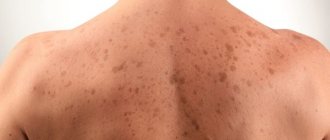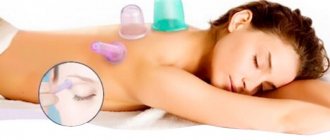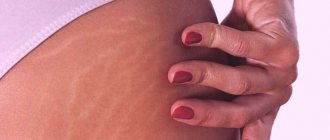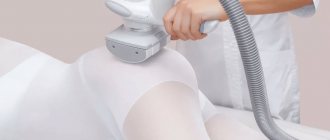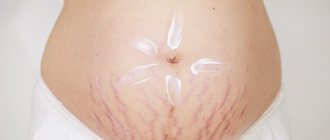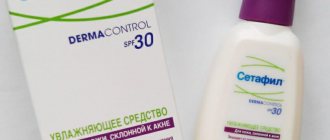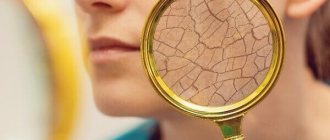Stretch marks or stretch marks are characteristic, dense to the touch, small scars of a pinkish or whitish hue that appear on various parts of the body. A lack of the collagen protein that gives the skin its elasticity leads to the appearance of small tears where the skin is most susceptible to stretching. The body, trying to eliminate microtraumas on its own, replaces healthy tissue with scar tissue in places of damage. As a result, stretch marks form. One of the main places where stretch marks appear is the stomach. Striae, as a rule, appear in the lower abdomen with prolonged overstrain of the muscles of the anterior wall of the peritoneum. The stretch may be single, but more often the stomach suffers from stretch marks of multiple localization. Women are usually susceptible to the formation of stretch marks on the abdomen. However, men and children are also not spared from their appearance.
Why do stretch marks appear on the thighs?
Stretch marks appear in places where the skin is chronically overstretched. When the skin produces insufficient collagen and elastin, and the body lacks amino acids necessary for restoration, the damage is filled with fast-growing connective tissue. As a result, oblong scars and stretch marks are formed.
There can be quite a few reasons for the appearance of stretch marks on the hips and legs, but a few main ones can be named:
- sharp fluctuations in body weight;
- growth spurt in teenagers;
- endocrine disorders;
- pregnancy;
- intense sports activities;
- genetic predisposition.
Apart from the last point, stretch marks occur during certain disruptions in the body. Extremely rapid weight changes, muscle growth—anything that is stressful for the body and directly affects the skin can cause stretch marks to appear. It is important to understand why you have stretch marks on your thighs in order to not only effectively deal with them, but also to eliminate related problems in the body.
While stretch marks are common during pregnancy or adolescence, in other cases they can indicate serious problems in the body. If you see no reason for the appearance of stretch marks, we recommend that you consult a doctor.
Find out which method of correcting scars and stretch marks is optimal for you!
doctor Svetlana Viktorovna Ogorodnikova.
doctor
Types of stretch marks
Stretch marks are usually divided into fresh and old. You can determine which type of stretch marks you have developed by their appearance.
| Fresh stretch marks | Old stretch marks |
| Red stretch marks on the thighs are fresh. Their age is usually no more than six months. The scars are quite bright; they can be not only red, but also purple. The easiest way to deal with fresh stretch marks is that they respond well to treatment, especially if you start eliminating stretch marks immediately after they appear. | Stretch marks become white over time, gradually becoming lighter. These scars are at least a year old and will be much more difficult to get rid of. |
Why stretch marks itch: reasons
You develop stretch marks when your skin stretches beyond its capacity, causing tears in the dermis (the second layer of skin just below the epidermis).
When stretch marks are fresh and developing, they appear red, purple, or pinkish (depending on your skin tone). That's when they itch.
Fresh stretch marks are itchy because the skin is thinner and has less collagen support. In addition, a skin tear also harms the nerves. Once the skin begins to heal, the damaged nerves are stimulated, causing an itchy sensation.
Additionally, if the skin around the stretch marks becomes dry, it may become itchy. In such cases, moisturizers may offer some relief. However, you should be especially careful when you develop itchy stretch marks on your stomach during pregnancy.
How to get rid of stretch marks on thighs?
Depending on the age of stretch marks on the legs and hips, the method of dealing with them is also selected. We suggest considering the main options and finding out the pros and cons of each approach.
Salon treatments
There are quite a lot of salon procedures to combat stretch marks, and new ones appear every day. Today there are several common services:
- Wraps . The procedure helps speed up blood circulation and metabolism, which is very effective for fresh stretch marks, but is unlikely to help in the case of old ones.
- Invasive procedures . Substances are injected into the areas where stretch marks appear to help destroy connective tissue and speed up skin regeneration. As in the previous case, they are effective for fresh stretch marks. For older people, it can only be used in combination with other procedures.
- Peels . The essence of peeling is to polish the skin - using a laser or a special composition, the connective tissue is destroyed, in its place healthy skin is formed. A very effective procedure if you choose the right drugs and number of sessions. However, it is also very painful, which can interfere with the elimination of stretch marks on the inner thighs and other sensitive areas. In addition, after peeling, a rehabilitation period is required, and the cost of all procedures can be quite hefty.
- Microdermabrasion . Mechanical damage to the skin to obtain a result similar to the effect of peeling. An effective, but rather traumatic method. During the recovery period, careful skin care is necessary.
- ELOS-rejuvenation (Electro-Optical Synergy). This procedure combines pulsed light and electric current. Atrophied areas warm up and decrease in size. Suitable for eliminating old stretch marks.
Pros: Most salon treatments have an overall healing effect on the skin. Along with getting rid of stretch marks, you can get increased elasticity, even out color and eliminate other imperfections.
Cons: Many options are quite traumatic and require a recovery period and careful care. In addition, salon treatments are the most expensive way to combat stretch marks . Especially if we are talking about old stretch marks, which may require several courses.
Massage
As with other procedures, massage is selected depending on the type of stretch marks and the presence of contraindications. Today they most often offer:
- Hydromassage . A pleasant procedure consisting of a massage using water jets and adding beneficial ingredients to the water. Unfortunately, it cannot be called effective, because... it can only help with fresh stretch marks.
- Hardware massage . It is performed with a special device with attachments for vacuum and vibration massage. The patient is put on an endormological suit, which helps reduce pain. Effective for fresh stretch marks; for old ones, a long course or combination with other methods of struggle may be required.
- Honey massage . One of the most pleasant types of massage. It is done manually, using natural honey or compositions based on it. The procedure only helps with fresh stretch marks, but it has a very beneficial effect on the skin as a whole and helps get rid of cellulite.
Pros : A well-executed massage will be useful not only as a fight against stretch marks, but also for tightening the skin, eliminating cellulite and as a relaxant.
Cons : Like salon treatments, massage is an expensive pleasure. At the same time, it is designed more to combat fresh stretch marks ; for old ones, you will have to combine procedures with other options.
Treatment for itchy stretch marks
It is important to keep the area hydrated as stretch marks develop. Moisturizing not only helps them fade, but also relieves itching by reducing dryness. Here are a few things you can try:
Cocoa
There is a lack of evidence to support the use of cocoa butter as an effective skin moisturizer. However, one small study suggests that cocoa butter may improve skin elasticity.
It is also widely used in cosmetic formulations, especially in moisturizing lotions, for its skin moisturizing abilities. You can try massaging the area with cocoa butter to keep the skin hydrated and prevent itching.
Coconut oil
Coconut oil is widely used in traditional medicine for healing several skin issues. This is an excellent moisturizer that helps reduce inflammation by improving transepidermal water loss and skin barrier function. Coconut oil also helps keep skin hydrated and hydrated. This property can also help smooth out stretch marks.
We recommend reading
Can Banana Peel Help Treat Psoriasis?
Vitamin E oil
Vitamin E oil (the liquid squeezed from softgels) is an extremely popular home remedy for maintaining hydrated skin. However, there is no scientific evidence of its moisturizing effect. Vitamin E is a powerful antioxidant and can support healthy skin.
In addition to the above ingredients, you can also use almond and jojoba oils or moisturizers.
You can also consult a dermatologist. They may suggest anti-itch ointments and topical creams or lotions to relieve the itching. Here are some more tips that may help reduce the itchiness of your stretch marks.
ethnoscience
Traditional medicine provides answers to almost any question - how to maintain youth, how to deal with skin imperfections and even overcome serious illnesses. Striae are no exception - there are many tips on how to remove stretch marks on the hips:
- Homemade scrubs. Honey-coffee scrubs are a compromise between massage and salon peeling. They exfoliate dead skin cells well and help destroy the connective tissue of stretch marks.
- Homemade wraps. It is most often recommended to use grape puree as a composition. Otherwise, the procedure is similar to the salon procedure, except that you will have to do the wrap yourself.
- Homemade cream for stretch marks. There are many recipes for such creams, but they have the same principle - mix solid, base and essential oils.
Pros : Most recipes contain simple ingredients that can be easily found in stores. You do not need to pay extra for specialist services or travel to the salon. In addition, all these procedures are pleasant and delight you with the aromas of fruits and essential oils.
Cons : The main disadvantage is one - the effectiveness of traditional medicine recipes is very doubtful. If you have fresh stretch marks, the chances are high that after scrubbing and supporting with vitamins, the skin will cope with the shortcomings, but old stretch marks are unlikely to be overcome. In addition, some home procedures can be dangerous. For example, using a homemade scrub can damage your skin.
Creams and gels
The main difference between store-bought creams and homemade creams is that the ratio of ingredients in them is precisely adjusted, and numerous tests have made it possible to obtain a truly effective and safe composition. In addition, some active substances will be very difficult for you to obtain on your own. For example, FERMENCOL® brand products contain an extract from crab liver. Agree, it will not be so easy to get it!
When choosing a suitable cream or gel, it is important to understand the purpose of the product. Here are some of the main types of products to combat stretch marks:
- Preventive . For example, creams and oils used during pregnancy to moisturize and increase skin elasticity. However, they will not affect existing stretch marks after childbirth.
- Remedies for fresh stretch marks . They are effective if the stretch marks on your thighs have not yet turned white.
- Remedies to combat old stretch marks . Such gels and creams contain active ingredients that allow you to cope even with old stretch marks that appeared more than a year or even several years ago.
Pros : Creams, oils, mousses and gels for stretch marks are the most budget-friendly of all the options that can be called effective. With the right product, you can deal with both fresh stretch marks and old ones, without trips to the salon or traumatic procedures. This is especially true for young mothers who cannot afford to leave home often and for a long time, but want to quickly return their skin to a healthy appearance.
Cons : It is very important to choose the right product and follow the instructions exactly . If a specialist does everything for you in the salon, then you need to approach the process yourself with full responsibility, do not skip procedures and apply the cream or gel within the prescribed period. Sometimes, to increase efficiency and speed up the process, the use of additional devices is required, but the good news is that they are not too expensive and are available for free sale.
External signs of pregnancy
A change in a woman’s appearance already in the early stages may indicate pregnancy.
Acne during pregnancy
A sharp hormonal change in the body of a pregnant woman and increased activity of the sebaceous glands can trigger the appearance of acne, even if the woman has not previously encountered this problem.
Most often, the rash goes away after the baby is born and does not require any treatment.
If a pregnant woman decides to deal with rashes before delivery, then she should remember that during this period it is forbidden to use drugs that contain retinoids and salicylic acid. In addition, removal of rashes using laser, deep peeling, or mechanical cleaning is contraindicated. Phytotherapeutic procedures should also be treated with caution.
Facial redness during pregnancy
Such an early sign of pregnancy as facial redness is associated not only with hormonal levels, but also with increased blood circulation during this period.
Many pregnant women experience the so-called “pregnant mask”, which is characterized by the appearance of age spots localized in the forehead, cheeks and nose. You should not be afraid of such spots, since after childbirth they will go away on their own over time.
Veins during pregnancy
The onset of pregnancy may be marked by the appearance of venous patterns (or spider veins) on the chest, neck, arms and legs. Such spider-like patterns of dark red or bluish color, like skin pigmentation, will disappear on their own with the birth of the child.
Edema during pregnancy
In the early stages of pregnancy, slight puffiness of the face may be observed. In addition, your hands may swell, which is especially noticeable if you clench your hand into a fist.
It should be remembered that swelling in the first months of bearing a child is not normal and may indicate that the expectant mother has kidney disease or cardiovascular disease. Therefore, if this symptom appears, you should consult a doctor.
Breast enlargement during pregnancy
Many women, due to the absence of menstruation, may suspect pregnancy in the first weeks of conception due to breast enlargement by 1 - 2 sizes. Moreover, this sign can be observed even if a woman loses her appetite and loses weight.
Breast enlargement may be accompanied by pain and tingling in both mammary glands.
Important! During pregnancy, both breasts increase in size exactly the same. Enlargement of one mammary gland or any part of it should alert you, as it may signal the presence of serious diseases.
Nipple changes during pregnancy
Early signs of pregnancy are darkening and swelling of the nipples, as well as the appearance of Montgomery tubercles - small outgrowths localized in the nipple area. Outwardly, such formations resemble small warts that are filled with a sebaceous substance.
There is no need to worry about the appearance of such tubercles, since they in no way disrupt the functioning of the sebaceous glands and do not affect the health of the expectant mother, much less the fetus.
Pain and burning sensations that occur when touching the nipples may also indicate pregnancy.
Discharge from the breast during pregnancy
An early (albeit rare) sign of conception may be clear fluid released from the nipple when pressure is applied to it.
Sometimes, in early pregnancy, colostrum may begin to be released, which indicates galactorrhea, a condition in which there is increased production of the hormone prolactin.
In general, the appearance of colostrum is more typical in the second and third trimesters of pregnancy.
Stripe on the stomach during pregnancy
Many people believe that a brown line on the abdomen, running from the navel down, appears in late pregnancy. In fact, this line can be seen already in the first weeks of pregnancy, it will simply be white, whereas from the 12th week it will begin to acquire a brown tint.
